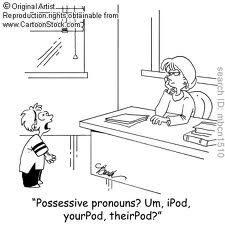Case part three
Nominative case—subject of a sentence and predicate nominatives
Objective case—Direct object and other things
That leaves possessive. Not very many people have trouble with this one, except for possessive pronouns and plurals. We’ll get to those in a moment.
Did you ever wonder where the apostrophe came from? English is a Germanic language, and the possessive form in German ends in -es. You can see this form in Old English. As time passed, we dropped the e and replaced it with an apostrophe, same as with contractions. So our possessive nouns are really contractions.
Here’s the rule for making correct possessive nouns:
- Look at the word you want to make possessive, plural or not.
- Does it end in “s”? Then add an apostrophe and you’re done. For example, my first name is Rogers. This blog is mine, so you could say that The Writing Rag is Rogers’ blog. If you pronounce it “Rogerses,” you are correct.
- No “s” at the end? Then add apostrophe-s and you’re done. My evil twin is Roger. He does not own this blog, so this is not Roger’s blog. You would pronounce this “Rogers.”
Why couldn’t you add apostrophe-s to Rogers? You could, but then you have a problem with words like waitress. Three of the same letter in a row is forbidden in English. (Can you think of the exception to this rule?)
On to the pronouns. Here’s the rule: Memorize them! His hers its. Not an apostrophe in sight. They are their own form. They are not nouns—don’t do the apostrophe! Harrumpf!


Leave a Reply